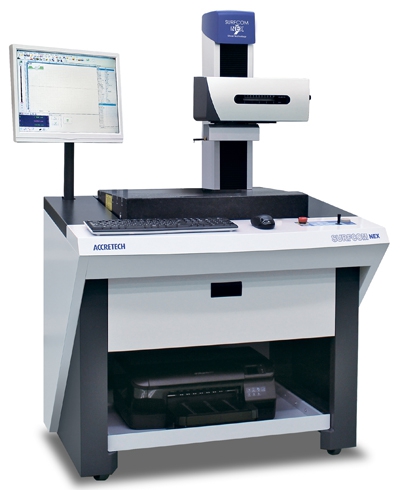
The NEX series of instruments from ZEISS Industrial Metrology integrate additional measurement analysis with their new detectors. SURFCOM NEX 100 offers a single hybrid detector to measure surface texture and contour at the same time. RONDCOM NEX Rs offers best-in-class spindle accuracy and allows optional surface roughness measurements in the horizontal, vertical and radial axes.
SURFCOM NEX 100 offers the highest accuracy in its class for roughness and contour measurements, and the analysis of both in one measuring run enhances measuring efficiency. Choose from multiple contour and roughness sensors to fit your application. The high-speed and low-vibration linear drive unit delivers long-term stable movement, for the highest measurement accuracy. This patented dual detector offers single data gathering at nano-level measurement resolution for roughness and contour profiling. The hybrid detector is also available for those interested in upgrading their existing linear surface systems from ZEISS.
SURFCOM NEX series has dedicated detectors with expanded contour range (60mm) and highest fidelity (0.1 nm resolution min.) for surface roughness. New features include a 30 percent larger standard granite table over existing machines, expanded to 133mm with T-slots for ease of part staging. Additional benefits of SURFCOM NEX include an improved detector safety mechanism, quick change magnetic contour arms that do not require requalification, optional T-stylus probing for up/downward tracing, automatic stylus force (NEX 040) and a temperature correction function for assured accuracy within 20ºC +/-5º.
The use of SURFCOM NEX is particularly beneficial for companies in the automotive, engineering, tool-making and medical technology industries where small and mid-sized precision parts such as nozzles, punching tools, rails for diesel engines and injector bodies are manufactured in large quantities.
RONDCOM NEX Rs offers best-in-class spindle accuracy and allows optional surface roughness measurements in the horizontal, vertical and radial axes. The offset detector holder allows various workpieces to be measured easily without interference from the R-axis arm. Measuring can be switched between outside diameter and top flatness simply by tilting the detector holder.
RONDCOM NEX series offers a larger table top (235mm) available with manual or auto tilt centering for fast and accurate part setup with rotation up to 20 rpm. New features include a full cover base and column to reduce environmental influences during the measurement cycle. Maximum performance is possible with the improved accuracy, low noise and vibration air spindle design, combined with a stainless steel table and expanded centering range (+/-5mm). The Z-axis column incorporates a linear scale for more precision positioning. Automatic column guideway lubrication assures years of maintenance-free operation. The light-weight, ceramic R axis with greater stiffness and a linear scale optimizes radial linear measurements for Z-axis straightness on tapered surfaces, spiral cylindricity and opposing diameter measurements.
There is also an option to measure periodic and fine twist structures of cylindrical shafts. This "lead twist" software extension evaluates by visualization and quantifying the twist surface structure created by the grinding feed process.
Detector positioning for ID/OD measurements, top/under/ tapered surfaces measurements, and so on can be controlled automatically. The same detector can also be used with all standard type roundness instruments from ZEISS and is also available with upgrades, which reduces maintenance costs by having the same sensor.
The RONDOM NEX system is an excellent solution for all geometric form analysis requirements that may be requested by the demands of Quality Assurance. Both systems are powered by the ACCTee PRO suite of surface and form measuring application software. Based on the "All in the Document!" file creation format, one file structure handles the measurement and analysis conditions, data point sets, CNC part programming and reporting. ACCTee PRO is Windows 7 based and provides the operator with an intuitive user interface to complete their inspection plans in the most logical and concise method.
Contact Details
Related Glossary Terms
- centering
centering
1. Process of locating the center of a workpiece to be mounted on centers. 2. Process of mounting the workpiece concentric to the machine spindle. See centers.
- computer numerical control ( CNC)
computer numerical control ( CNC)
Microprocessor-based controller dedicated to a machine tool that permits the creation or modification of parts. Programmed numerical control activates the machine’s servos and spindle drives and controls the various machining operations. See DNC, direct numerical control; NC, numerical control.
- feed
feed
Rate of change of position of the tool as a whole, relative to the workpiece while cutting.
- grinding
grinding
Machining operation in which material is removed from the workpiece by a powered abrasive wheel, stone, belt, paste, sheet, compound, slurry, etc. Takes various forms: surface grinding (creates flat and/or squared surfaces); cylindrical grinding (for external cylindrical and tapered shapes, fillets, undercuts, etc.); centerless grinding; chamfering; thread and form grinding; tool and cutter grinding; offhand grinding; lapping and polishing (grinding with extremely fine grits to create ultrasmooth surfaces); honing; and disc grinding.
- metrology
metrology
Science of measurement; the principles on which precision machining, quality control and inspection are based. See precision machining, measurement.
- profiling
profiling
Machining vertical edges of workpieces having irregular contours; normally performed with an endmill in a vertical spindle on a milling machine or with a profiler, following a pattern. See mill, milling machine.
- quality assurance ( quality control)
quality assurance ( quality control)
Terms denoting a formal program for monitoring product quality. The denotations are the same, but QC typically connotes a more traditional postmachining inspection system, while QA implies a more comprehensive approach, with emphasis on “total quality,” broad quality principles, statistical process control and other statistical methods.
- stiffness
stiffness
1. Ability of a material or part to resist elastic deflection. 2. The rate of stress with respect to strain; the greater the stress required to produce a given strain, the stiffer the material is said to be. See dynamic stiffness; static stiffness.
- surface texture
surface texture
Repetitive or random deviations from the nominal surface, which form 3-D topography of the surface. See flows; lay; roughness; waviness.

